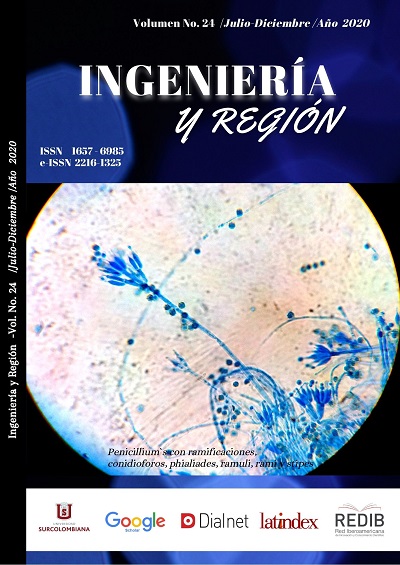Description of the control of a passive dehydrator and its effect on temperature regulation in the dehydration process of Stevia leaves (Stevia rebaudiana Bertoni)
##plugins.themes.bootstrap3.article.main##
Stevia leaves (Stevia Rebaudiana Bertoni) have become important due to their high sweetening power, so their consumption has increased in recent years. The highest sweetener content is generally found in the dried leaves; allowing temperature contro become an important study parameter. The present research, explains the effect of the implementation of a closed loop control system implemented through Arduino technology and conventional electronics. Temperature regulation was analyzed with a PID (Proportional, Integral, Derivative Control) for a drawer type solar dehydrator. Through a graphical user interface (GUI) in Matlab, the dehydration process of Stevia (Stevia Rebaudiana Bertoni) was monitored through three different desired temperatures 30 ℃, 35 ℃ and 40 ℃. Finally, in the analysis of results, the effect of temperature on the dehydration process must be studied through the quantification of the percentage of its active substances present in the leaves using the L standard at 630 nanometers. The results showed that 35°C is the optimum temperature for the dehydration of Stevia leaves. On the other hand, the passive tyoe dehydration of temperature is a feasible option for its application in the dehydration of Stevia leaves.
Downloads
##plugins.themes.bootstrap3.article.details##
Alberti, P. 2006 Los aportes de las mujeres rurales al conocimiento de plantas medicinales en México. Análisis de Genero. Agricultura, Sociedad y Desarrollo, Vol. 3, No. 2, pp. 139-153.
Barbosa-Canovas, G. V., y Ibarz, A. (2005). Operaciones unitarias en la ingeniería de alimentos. Mundi-Prensa Libros.
Bernabe E., Romantchik E., Cebada J. G. and Velázquez N. 2018. Design of a Position Control for a Cutting System of a Maize-Husking Machine. IEEE Latin American Trasanction., Vol. 16, No. 4, pp. 115–117. https://doi.org/10.1109/tla.2018.8362132
Castañeda, A., González A., Guzmán R., and Ibarra O. 2012. Desarrollo de un horno solar para el secado de plantas y vegetales usando control difuso. Revista Acta Universitaria, Vol.22, No. 3, pp. 14-19. https://doi.org/10.15174/au.2012.380
Cebada J. G, Hahn F. F., Ruiz A., and Michua A. 2016. Design of a Position Control Based on Cuckoo Search Tuning for a Cutter Leaves Robot. IEEE Latin America Transaction, Vol. 14, No. 5, pp 2085-2092. https://doi.org/10.1109/tla.2016.7530399
Cerino I. and Chávez E., 2018. Efficiency of tunnel type solar dryer with cocoa (Theobroma Cacao L.) in Tabasco. Revista Mexicana de Ciencias Agrícolas, Vol. Special, No. 21, pp. 1 -10. https://doi.org/10.29312/remexca.v0i21.1528
Cerino I., López Cruz I., Serm, M. Busarakon J. and Marcus N., 2019. Mathematical modelling of the thin layer drying of pineapple (Ananas comosus, L.): experiment at village-scale in a greenhouse type solar dryer. Revista Ingeniería Investigación y Tecnología UNAM, Vol. XX, No. 2, pp. 4395-4405. https://doi.org/10.22201/fi.25940732e.2019.20n2.016
Duran S., Rodríguez M., Cordón K and Record J. 2012. Estevia (stevia rebaudiana), edulcorante natural y no calórico. Revista chilena de nutrición, Vol. 39, No. 4, pp 203-206. https://doi.org/10.4067/s0717-75182012000400015
Garcia, F. J. 2014. Evaluación de los procesos de secado sobre la calidad de la Stevia (Stevia Rebaudiana) y la Hierbabuena (Mentha Spicata sp). M. S. thesis, Dept. Civil and agricultural Engineering. Nacional Univ., Bogotá, Colombia, 144pp. https://doi.org/10.31910/rudca.v18.n2.2015.165
Hidar N., Ouhammou M., Mghazli S., Idlimam A., Hajjaj A. and Bouchdoug M. 2020. The impact of solar convective drying on kinetics, bioactive compounds and microstructure of stevia leaves. Renewable Energy, Elsevier, pp 1-28. https://doi.org/10.1016/j.renene.2020.07.124
Landázuri, P., & Tigrero, J. 2009. Stevia rebaudiana Bertoni, una planta medicinal. Bol. Téc. Edición Especial. ESPE. Sangolquí, Ecuador, 1-38.
Lemus-Mondaca R., Ah-Hen K., Vega-Gálvez., A., Honores C. and Moraga N. 2015. Stevia rebaudiana Leaves: Effect of Drying Process Temperature on Bioactive Components, Antioxidant Capacity and Natural Sweeteners. Plant Foods for Human Nutrition (Plant Foods Hum Nutr), Springer, pp 49-56. https://doi.org/10.1007/s11130-015-0524-3
Lemus-Mondaca R., Vega-Gálvez A., Rojas P., Stucken K., Delporte C., Valenzuela-Barra G ande Jagus J. 2018. Antioxidant, antimicrobial and anti-inflammatory potential of Stevia rebaudiana leaves: effect of different drying method. Journal of Applied Research on Medicinal and Aromatic. https://doi.org/10.1016/j.jarmap.2018.10.003
Marques G. and Pitarma R. 2019 Non-contact Infrared Temperature Acquisition System based on Internet of Things for Laboratory Activities Monitoring. The 9th International Conference on Sustainable Energy Information Technology (SEIT), Halifax, Canada, August 19-21. https://doi.org/10.1016/j.procs.2019.08.068
Martínez Cruz, M. 2015. Stevia rebaudiana (Bert.) Bertoni. Una revisión. Cultivos tropicales, 36, 5-15.
Martínez Pérez, T. 2002. La hierba dulce. Historia, usos y cultivo de la Stevia Rebaudiana Bertoni. Ciencias.
Mousa M., Oudat E. and Claudel C., 2015. A Novel Dual Traffic/Flash Flood Monitoring System Using Passive Infrared/Ultrasonic Sensors. IEEE 12th International Conference on Mobile Ad Hoc and Sensor Systems, Dallas, TX, USA, Oct. 19-22. https://doi.org/10.1109/mass.2015.61
Muratore G., Rizzo V., Licciardello F. and Maccarone E., 2008. Partial dehydration of cherrytomato at different temperature, and nutritionalquality of the products. Food Chemestry, Vol. 111, No. 4, pp. 887-891. https://doi.org/10.1016/j.foodchem.2008.05.001
Ogata K., 1977. Ingenieria de control modern. Prentice Hall, Vol. 3, Madrid, pp. 238-261.
Periche, A., Koutsidis, G., & Escriche, I. 2014. Composition of antioxidants and amino 395 acids in Stevia leaf infusions. Plant Foods for Human Nutrition, 69, 1-7. https://doi.org/10.1007/s11130-013-0398-1
Reyes F. 2011. Robótica. Control de robots manipuladores. AlfaOmega, Vol. 1, México DF, pp. 357-358.


















